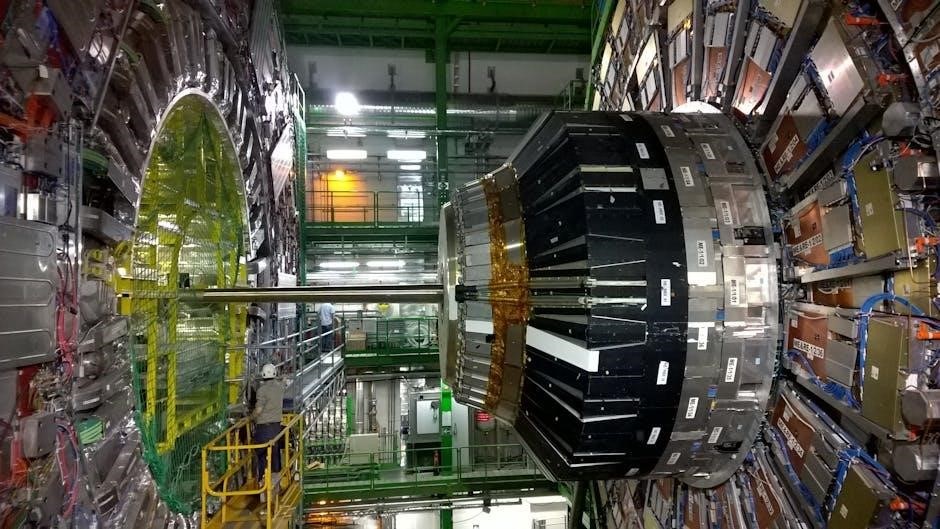The AQA A Level Physics specification offers a comprehensive, well-structured curriculum blending theoretical foundations with practical applications, designed to foster deep understanding and critical thinking in students.
Overview of the Specification
The AQA A Level Physics specification is a detailed and structured framework designed to guide students through a comprehensive understanding of physics. It outlines the core content areas, including mechanics, fields, nuclear physics, and optional topics like astrophysics and medical physics. The specification emphasizes the development of practical skills and theoretical knowledge, ensuring students can apply scientific principles to real-world scenarios. It also provides clear guidance on assessment, including internal evaluations of practical work and required practicals. The document is divided into manageable sections, making it easy for teachers and students to navigate. Regular updates ensure the content remains relevant and aligned with contemporary scientific advancements, preparing students for further study or careers in science and engineering.
Why Choose AQA for A Level Physics
Choosing AQA for A Level Physics provides students with a well-rounded and engaging curriculum that fosters a deep understanding of scientific principles. AQA is a trusted and experienced exam board, offering comprehensive resources and support for both teachers and students. The specification is designed to be co-teachable for AS and A Level, allowing for flexibility and continuity in learning. AQA also provides a range of optional modules, enabling students to explore specialized areas of interest. Additionally, the emphasis on practical skills and real-world applications prepares students for future careers in science and engineering. With clear assessment criteria and robust exam security, AQA ensures a fair and reliable evaluation process, making it an excellent choice for A Level Physics.

Core Content Areas
The AQA A Level Physics specification covers essential topics such as mechanics, thermal physics, fields, and nuclear physics, blending theoretical concepts with practical applications to build foundational knowledge.
Further Mechanics and Thermal Physics
This section builds on foundational mechanics and introduces advanced thermal physics concepts. Students explore motion, forces, energy, and momentum in depth, applying Newton’s laws to complex systems. Thermal physics covers the kinetic theory, ideal gases, and thermodynamic processes, emphasizing the practical applications of heat transfer and energy conversion. Practical investigations, such as analyzing engine cycles and energy efficiency, are integral to developing problem-solving skills. The content fosters a deep understanding of physical principles and their real-world implications, preparing students for higher-level study in physics or engineering. This area is crucial for developing analytical and mathematical reasoning abilities, essential for tackling advanced physics problems.
Fields and Their Consequences
This module delves into the fundamental concept of fields in physics, exploring electric, magnetic, and gravitational fields. Students learn to describe and analyze field patterns, forces, and energies, building on earlier studies of electromagnetism. The section emphasizes the consequences of field interactions, such as induction and the behavior of charged particles in magnetic fields. Practical applications, like electromagnetic waves and their technological uses, are also covered. The content reinforces mathematical modeling and problem-solving skills, enabling students to predict and explain phenomena in diverse contexts, from particle accelerators to everyday electrical devices. This area bridges theoretical concepts with real-world applications, enhancing students’ understanding of the natural and engineered world.
Nuclear Physics
Nuclear Physics explores the structure, properties, and interactions of atomic nuclei, focusing on key concepts such as nuclear stability, radioactive decay, and nuclear reactions. Students investigate the composition of nuclei, including protons, neutrons, and binding energy, and analyze the processes of alpha, beta, and gamma decay. The module also covers nuclear fission and fusion, highlighting their applications in energy production and weaponry. Practical applications, such as medical isotopes and radiation detection, are emphasized. Mathematical skills are developed through the study of nuclear equations, half-life calculations, and the application of Einstein’s mass-energy equivalence. This section provides a deep understanding of the nucleus and its role in modern technology, while addressing ethical and environmental implications of nuclear energy.

Optional Topics
Optional topics allow students to specialize in areas like astrophysics, medical physics, engineering physics, turning points in physics, and electronics, combining theoretical depth with practical applications.
Astrophysics
Astrophysics explores the physics of celestial objects and phenomena, including stars, galaxies, and cosmic events. Students analyze the life cycles of stars, gravitational forces, and the expansion of the universe. Key topics include stellar formation, black holes, and the detection of exoplanets. Practical work involves interpreting astronomical data and using spectroscopy to study light from distant objects. This optional topic bridges theoretical physics with observational astronomy, fostering analytical and problem-solving skills. It aligns with modern scientific advancements, inspiring curiosity about the universe’s fundamental nature. Astrophysics encourages students to think critically about the cosmos and humanity’s place within it, making it a compelling choice for those passionate about space and its mysteries.
Medical Physics
Medical Physics applies fundamental physical principles to medical applications, focusing on technologies like MRI, X-rays, and radiation therapy. Students explore how physics underpins diagnostic and therapeutic techniques, improving healthcare outcomes. Key topics include imaging technologies, radiation interactions, and the physics of the human body. Practical work involves analyzing medical data and understanding safety protocols. This optional topic highlights the intersection of physics and medicine, preparing students for careers in medical research or healthcare. By studying Medical Physics, learners gain insights into modern medical advancements and the role of physics in saving lives, making it a valuable and impactful choice for those interested in healthcare applications of physical sciences.
Engineering Physics
Engineering Physics focuses on applying fundamental physical principles to solve real-world engineering challenges. This optional topic explores the physics behind material properties, stress analysis, and structural integrity, preparing students for careers in engineering. Key areas include the behavior of materials under different conditions, fluid dynamics, and thermodynamics. Students learn to design and optimize systems, such as bridges or engines, using physics-based problem-solving. The topic emphasizes practical applications, enabling learners to understand how theoretical concepts translate into practical solutions. By studying Engineering Physics, students gain a deep understanding of the interplay between physics and engineering, equipping them with the skills to tackle complex problems in various engineering fields.
Turning Points in Physics
Turning Points in Physics explores pivotal moments in the history of physics that fundamentally changed our understanding of the universe. This optional topic delves into groundbreaking discoveries and their impact on modern physics. Students examine key milestones, such as Newton’s laws of motion, Maxwell’s unification of electromagnetism, and the quantum revolution led by figures like Planck, Einstein, and Bohr. The topic also covers the development of relativity and the emergence of quantum mechanics, highlighting how these ideas transformed scientific thought. By studying these turning points, learners gain insight into the evolution of physical theories and their experimental verification. This module fosters a deeper appreciation of how historical breakthroughs continue to shape contemporary physics and its applications.
Electronics
The Electronics topic within the AQA A Level Physics specification provides students with a detailed understanding of electronic systems and their applications. This optional module covers essential concepts such as electronic circuits, components, and their functionalities. Students explore the principles of circuit design, including resistors, capacitors, inductors, and semiconductors, while gaining practical skills in circuit analysis and construction. The topic also delves into digital electronics, including logic gates and microprocessors, highlighting their role in modern technology. Emphasis is placed on the practical applications of electronics in real-world scenarios, such as communication systems and control technologies. By studying electronics, learners develop problem-solving skills and an appreciation for how electronic systems underpin everyday devices and innovations.

Practical Skills and Assessment
Practical skills are central to AQA A Level Physics, linking theory to real-world applications through experiments. Internal assessment evaluates experiment design, data analysis, and scientific reasoning, preparing students for STEM careers.
Internal Assessment of Practical Work
The internal assessment of practical work in AQA A Level Physics focuses on evaluating students’ experimental skills, data analysis, and scientific reasoning. This component emphasizes hands-on learning, allowing students to design and conduct experiments, collect data, and draw meaningful conclusions. The assessment is divided into two routes: Route T, which maintains continuity with previous specifications, and Route S, offering a fresh approach. Both routes require students to complete required practicals, such as investigating forces, waves, and electricity. These activities are integral to developing practical skills and linking theoretical concepts to real-world applications. The internal assessment also encourages critical thinking and problem-solving, preparing students for careers in STEM fields. Regular feedback from teachers helps refine experimental techniques and analytical abilities, ensuring students are well-prepared for their final assessments.
Required Practicals and Their Significance
The AQA A Level Physics specification includes ten required practicals, each designed to provide students with hands-on experience in experimental physics. These practicals cover key areas such as forces, waves, and electricity, ensuring a broad understanding of fundamental concepts. They are integral to developing skills in experimental design, data collection, and analysis. The practicals also emphasize the evaluation of results, fostering critical thinking and problem-solving abilities. By engaging in these activities, students gain practical skills that are essential for scientific inquiry and real-world applications. The required practicals also prepare students for independent study and future careers in STEM fields, reinforcing the connection between theoretical knowledge and practical application. They are a cornerstone of the specification, promoting deeper learning and intellectual curiosity.

Revision and Study Strategies
Effective revision involves creating a structured plan, engaging in active study techniques, understanding key concepts deeply, and prioritizing mental and physical well-being for academic success.
Structured Revision Plan and Active Learning Techniques
Creating a structured revision plan is essential for success in AQA A Level Physics. This involves setting clear goals, allocating time for each topic, and avoiding procrastination. Active learning techniques, such as summarizing notes, creating concept maps, and engaging in problem-solving, enhance understanding and retention. Regular practice with past papers helps familiarize students with exam formats and improves time management. Consistency is key; spreading study sessions over time ensures deeper absorption of content. Additionally, seeking clarification on challenging topics and utilizing online resources can strengthen comprehension. By combining organization with engaging study methods, students can master the specification effectively and achieve their academic goals. Regular review of progress ensures adjustments can be made to stay on track.
Importance of Past Papers and Exam Technique
_past papers are invaluable for preparing students for AQA A Level Physics exams. They provide insights into exam formats, question types, and time management. Practising past papers helps students familiarize themselves with the structure and content, reducing anxiety and improving performance. Additionally, exam technique is crucial; students must learn to present answers clearly, address all parts of questions, and allocate time effectively. Active learning techniques, such as summarizing key concepts and engaging in problem-solving, complement past paper practice. Regular review of past papers identifies strengths and weaknesses, allowing targeted revision. By mastering exam technique and consistently practising past papers, students can refine their approach and achieve their full potential in the AQA A Level Physics exams._

